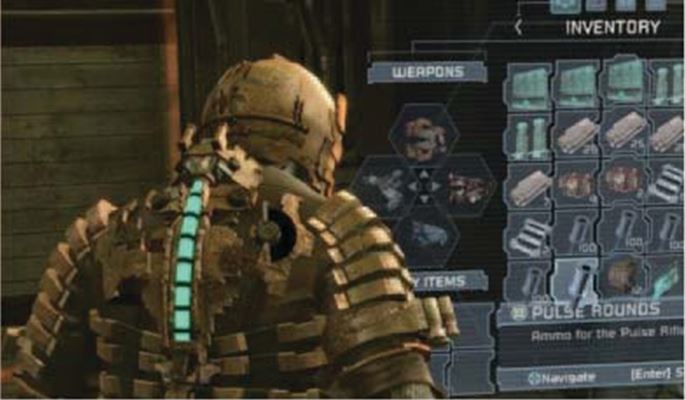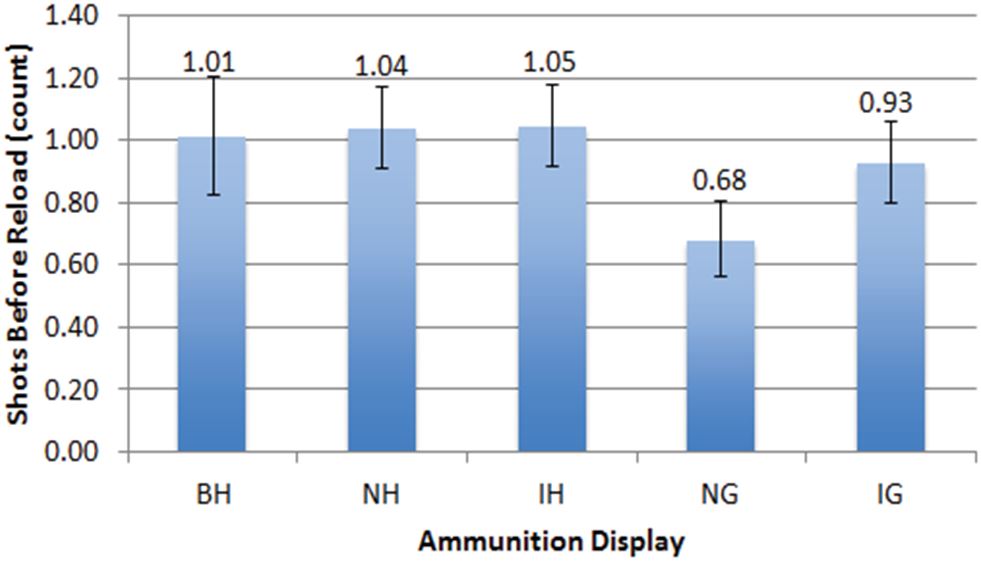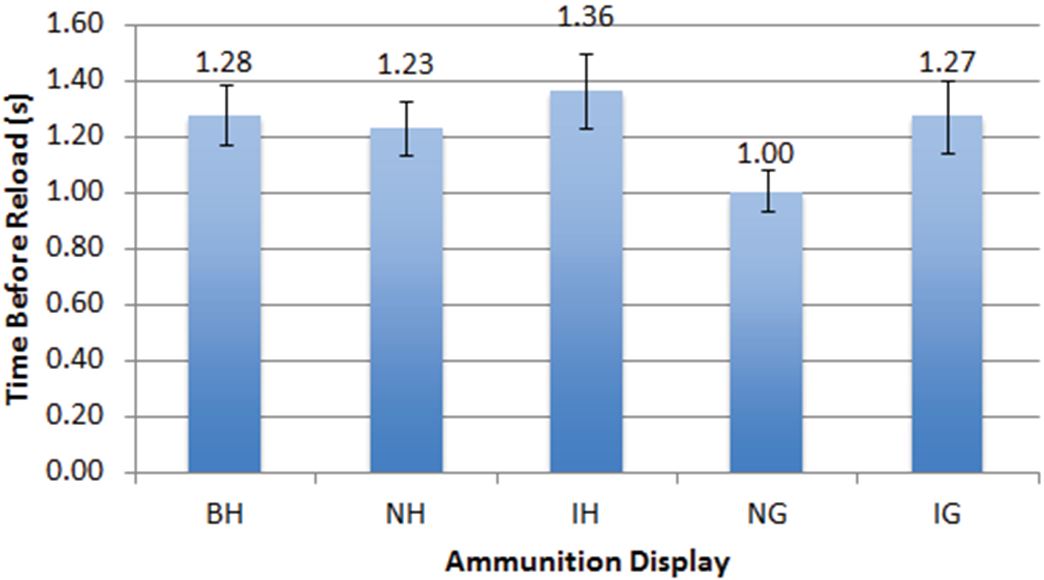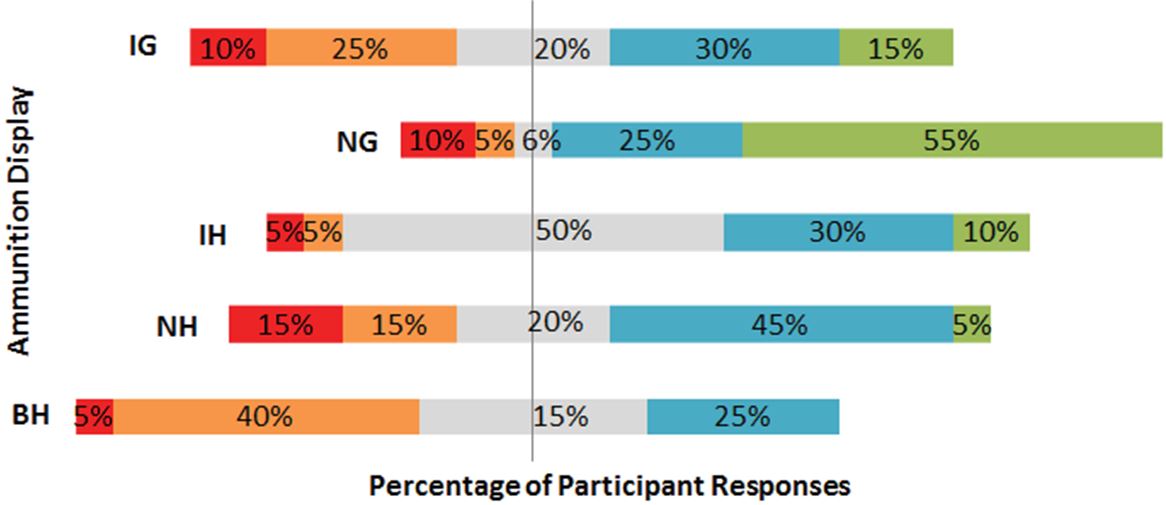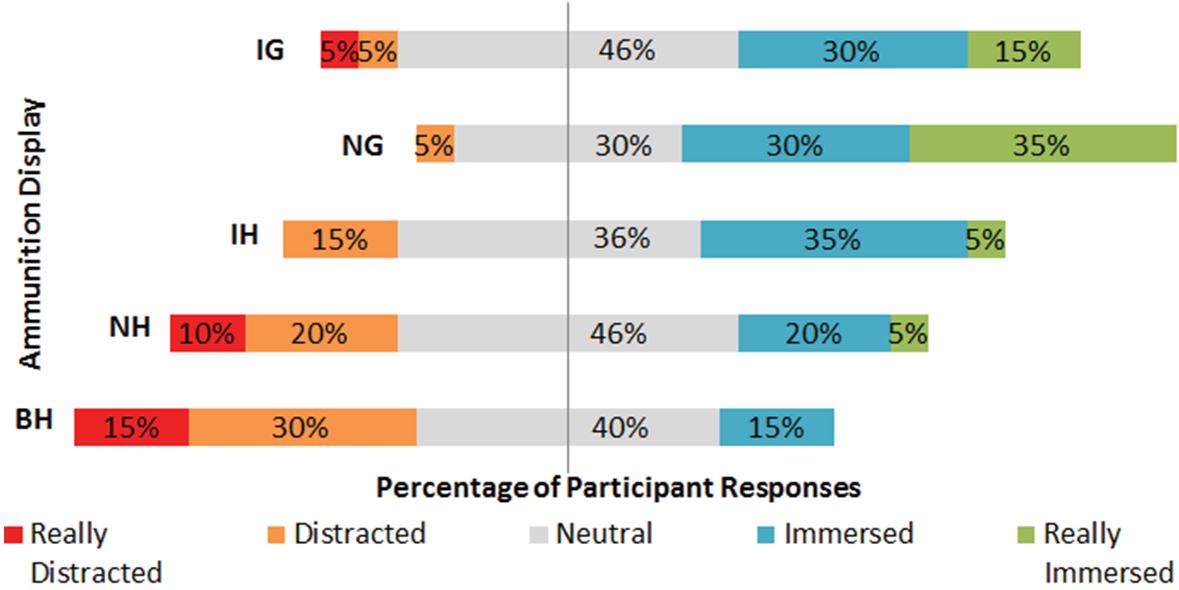Peacocke, M., Teather, R. J., Carette, J., & MacKenzie, I. S. (2016). Evaluating the effectiveness of HUDs and diegetic ammo displays in first-person shooter games. Proceedings of the 7th IEEE Consumer Electronics Society Games, Entertainment, Media Conference - IEEE-GEM 2015, pp. 1-8. New York: IEEE. doi: 10.1109/GEM.2015.7377211 [PDF]
Abstract – We present an experiment comparing five ammunition display methods in first-person shooter (FPS) games. These included both diegetic (in-game) and heads-up display (HUD) options. HUD displays included a bar, icons, and a counter. Diegetic displays were displayed in-game beside the player's weapon. Two diegetic displays were evaluated: a number and bullets. We compared the performance offered by each ammunition display and player preference towards each. Results indicate that the diegetic "number-in-game" display performed best both in terms of reload time and shots taken between running out of ammunition and reloading. Participants fired an average of 35% fewer shots after running out of ammo with the number-in-game display than with the worst performing display, icons-on-HUD. Reload time was also 26% faster with the number-in-game display than with icons-on-HUD. The number-in-game display was preferred by 70% of participants. Evaluating the Effectiveness of HUDs and Diegetic Ammo Displays in First-person Shooter Games
Margaree Peacocke1, Robert J. Teather1, Jacques Carette1, I. Scott MacKenzie2
1 Dept. of Computing & Software
McMaster University Hamilton, ON, Canada
{peacocke | teather | carette}@mcmaster.ca2 Dept. of Electrical Engineering & Computer Science
York University Toronto, ON, Canada
mack@cse.yorku.ca
Keywords – First-person shooter, video games, diegetic, head-up display, interface, ammunition
I. INTRODUCTION
In first-person shooter (FPS) games, the player acts as a gunman seeing the game world from the first-person perspective while completing missions. FPS games are wildly popular. Forbes reports 3 of the top 10 bestselling games of 2014 were FPS games [1]. FPS games have the potential to earn companies huge profits. For example, Activision's Call of Duty: Modern Warfare 3 earned $400 million in the first 24 hours after release and $1 billion within 16 days [2]. Player engagement with these games is crucial to their success.
Due to the widespread success of the genre and the large user base, FPS games are interesting platforms for HCI research. Most research thus far focuses on input-related issues, for example, improving aiming or navigation. While these input-related tasks are undoubtedly relevant in designing improved UIs for FPS games, we argue that information displays have been comparatively under-explored. We thus focus on the output-related task of effectively displaying and conveying in-game information to the player.
Feedback has long been recognized as a crucial factor in user interface design [3]. When displaying in-game information, "feedback is crucial for player learning and satisfaction with the game" [3, p. 19]. Schaffer [4] argues that heads-up display (HUD) elements located on the periphery of the display occupy very little game space. Hence, they do not distract from gameplay, yet effectively present necessary information to the player. Fig. 1 depicts example HUDs from commercially available FPS games.
(a)
(b)
(c)
Fig. 1. Example HUD displays. (a) Call of Duty: Strike Team, depicting controls (soft buttons, left-side), health (variation of bar), and ammunition as a number and bar; (b) Tom Clancy's Rainbow Six: Vegas, depicting ammunition numerically; (c) Call of Duty: Ghosts depicting ammunition both numerically and as a bar/meter.
Nevertheless, game designers may gravitate away from HUDs, as they increasingly attempt to produce more immersive experiences. Game immersion occurs when players "voluntarily adopt the game world as a primary world and reason from the character's point of view" [5, p.69]. HUDs may compromise immersion, so one alternative is the use of diegetic displays [6]. With diegetic displays, game status information is conveyed using an in-game method rather than on the HUD [5]. Information displayed in the game space and integrated with the game fiction is considered diegetic [12].
Many types of in-game information can be displayed using a diegetic display. For example, displaying the player's current weapon by rendering it held by the character model (rather than showing its name or icon on the HUD) is a diegetic display. The weapon is visible within the game space and is part of the game fiction. The developers of several best-selling FPS games (see Table 1) used diegetic displays in an effort to enhance immersion. Fig. 2 depicts diegetic displays.
(a)(b)
Fig. 2. Diegetic game displays. (a) Metro 2033. (b) Dead Space displays the health meter (blue bar mounted on player's back) diegetically. The in-game inventory is also presented like an augmented reality display floating in front of the player.
We thus investigate the effectiveness of diegetic displays relative to HUDs in terms of both player performance and enjoyment. There is relatively little quantitative research on the effectiveness of diegetic displays – most work in this realm is qualitative [5, 7, 8]. Our primary research question is whether diegetic displays yield performance comparable to HUDs. If diegetic displays offer better (or, at least, not worse) performance than HUDs, this makes a strong argument for their use, especially in mobile contexts.
We first present an analysis of recent FPS games to identify the most important information displayed during gameplay. Based on previous work [9], "remaining ammunition" was selected for further study, as it is critical in a player's vulnerability assessment [10]. It is information consistently displayed in virtually all FPS games [9], and hence important for study.
Following this analysis, we present an experiment comparing several HUD and diegetic ammunition displays. The ammunition displays were chosen based on the results of our analysis of recent FPS games. The study used a custom-developed FPS game. We compared three common HUD and two diegetic ammunition displays.
The ammunition displays (and their short-hand names) are:
HUD:
- Bar-on-HUD (BH)
- Number-on-HUD (NH)
- Icons-on-HUD (IH)
Diegetic:
- Number-in-game (NG)
- Icons-in-game (IG)
We solicited participants who regularly play FPS games, since skilled gamers can quickly assess their status, while novice players cannot [10]. Hence expert gamers should be skilled enough to elicit differences between the conditions studied. In contrast, novice participants require training to get to this level of skill, and thus may not reveal differences between the experimental conditions.
II. RELATED WORK
To date, the comparative performance of HUD and diegetic displays has received little attention. Recent studies on FPS information displays have primarily been qualitative in nature [5, 7, 8]. There is little empirical work comparing performance of diegetic and non-diegetic elements. Yet player performance is an important aspect of enjoyment, and directly impacts player effectiveness. For example, Babu [11] compared immersion levels in two games with diegetic displays, Metro 2033 and Dead Space, with two games with HUDs, Bioshock and Resident Evil 5. Immersion was assessed significantly different between the display types. Participants instead suggested that graphics and storyline had a stronger impact on their sense of immersion.
Galloway [12] introduced the terms diegetic and non-diegetic to the study of video games. The terms originated in literary and film theory. He defines game diegesis as "the game's total world of narrative action" [12, p.7], and non-diegetic as "gamic elements that are inside the total gamic apparatus yet outside the portion of the apparatus that constitutes a pretend world of character and story" [12, pp. 7- 8]. He concludes that the HUD is a non-diegetic element.
Fagerholt and Lorentzon [5] built on this work, developing a descriptive model categorizing FPS UI elements based on two factors: whether the element exists (or not) in the fictional world, and if it is a part of the 3D game space (or not). They recommend considering the game's fiction when deciding if information should be displayed diegetically, arguing that game coherence is paramount. For example, diegetic options make sense in a game like Dead Space, as its futuristic setting allows designers to explain diegetic displays as future technologies such as augmented reality displays or holograms. Ultimately, the authors suggest using diegetic displays when appropriate and cohesive. However, the merit of this is suspect in the absence of empirical results assessing the potential performance impact of such a design choice.
Similarly, Fragoso [7] conducted a qualitative study on the effects of diegetic displays on player immersion. Participants played EA's Battlefield 3, which is considered more immersive than other games due to the minimal use of the HUD, relying more on diegetic displays. Participants reported that their gameplay was disrupted by a lack of meaningful feedback and the relative vagueness of the displays. The authors conclude that effective feedback is actually more important than realism. They further report that HUD-based UI elements were less disruptive than their diegetic counterparts. These sentiments are echoed by Llanos and Jørgensen [8] who report that while players liked the aesthetic appeal of diegetic displays, they more greatly valued clear communication of game information. However, they also note that players become annoyed when excessive amounts of information are displayed on HUDs.
Conroy et al. [10] studied the level of agreement between players' anticipated and actual responses to specific game scenarios in Quake III. Players were first asked how they would respond to a specific scenario. Then, they played the game while encountering these scenarios. More experienced participants demonstrated substantially higher levels of agreement between their questionnaire responses and actual responses. They tended to have better awareness of in-game information, such as ammunition levels. Less-skilled players handled their resources (e.g., ammo) more poorly, resulting in greater deviation between their anticipated responses to scenarios. This suggests that the choice of in-game displays is highly relevant to novice players. Nevertheless expert players are likely to also benefit from more effective displays.
Applicable game interface design heuristics also exist for communicating status. For example, Federoff states that "The interface should be as non-intrusive as possible" [13, p. 13] and that "a player should always be able to identify their score/status in a game" [13, p. 13]. We argue that empirical studies on the effectiveness of these displays are needed to complement existing qualitative work and design heuristics.
Zammitto [14] conducted a visual analysis of Valve's Half Life 2 to assess if visualization design principles were applied in the presentation of game information. They found that the game applied two principles to its HUD ammunition display: silhouette (showing a bullet icon) and colour coding (changing ammunition indicator from yellow to red when ammunition was low). A similar approach was used in the game's health indicators. Overall, Zammitto concluded that information visualization is not well used in video games, as it is a developing field.
Bowman et al. [15] share this sentiment, and suggest that because data visualization in games is new, it is relatively underutilized. They analyzed visualization in games and proposed a design framework. Their framework classifies critical game information as Status, noting that "visual representations are often chosen in lieu of a simple number … because the game designers feel that visualization is more immersive and easier to read quickly" [15, p. 1961]. They recommend considering the target audience before deciding on a particular visualization and ensuring that "the visualization is in spirit with the game's atmosphere and integrated within the game" [15, p. 1962]. This is consistent with research mentioned earlier [5]. The consensus is that players value cohesion in games. Proper data visualizations improve players' awareness of their current state.
III. CURRENT GAMES ANALYSIS
We undertook an analysis of several recent popular shooter games across multiple platforms. These games were selected for their popularity, in sales and awards, and because they are available for large and small screen platforms. The purpose was to learn what information was consistently displayed, and how it was displayed. The intent was to narrow down the most critical type(s) of information displayed to study experimentally. The games analyzed included Activisions' Call of Duty: Strike Team, Call of Duty: Black Ops, Call of Duty: Ghosts, Ubisoft's Tom Clancy's Rainbow Six: Vegas, Bioware's Mass Effect 3, Mass Effect Infiltrator and EA's Dead Space. The analysis involved playing these games, watching gameplay videos, and reading publicly available game reviews.
Four pieces of information were common to all games: player health, ammunition display, current weapon, and a navigational aid. We thus argue that these are the most important information displays in FPS games. The display methods used for health, ammo, weapon, and navigational aid are shown in Table 1. Games utilizing diegetic displays are shaded, with the diegetic option set in boldface. Note that navigational aid is nearly universally displayed as a mini-map in multiplayer mode, but as a navigational arrow in single-player campaign mode. Our analysis focused exclusively on single-player campaign modes.
TABLE 1
Analysis of Current Game Displays for Health, Remaining Ammunition, and Current Weapon. Diegetic Options are set in Boldface Font.
Game Platform (Year) Health Display Ammo Display Weapon Display Navigational Aid Call of Duty: Strike Team iOS (2013) Bar Icons-on-HUD + Number-on-HUD Icon + In Front Arrow Call of Duty: Black Ops PC (2010) Blood Spatter Number-on-HUD Name + In Front Arrow Call of Duty: Black Ops Nintendo DS (2010) Blood Spatter Number-on-HUD Name Mini-map Call of Duty: Ghosts PC (2013) Blood Spatter Number-on-HUD + Bar-on-HUD In Front Arrow Tom Clancy's Rainbow Six: Vegas Sony PSP (2007) Bar Icons-on-HUD Name + Icon + In Front Arrow Tom Clancy's Rainbow Six: Vegas PC (2006) Blood Spatter Number-on-HUD Name + In Front Arrow Mass Effect 3 PC (2012) Bar Number-on-HUD + Bar-on-HUD Icon + In Front Arrow Mass Effect Infiltrator iOS (2012) Bar Bar-on-HUD Icon + In Front Arrow Dead Space PC (2008) Bar in game Number-in-game In Front Arrow Dead Space iOS (2011) Bar in game Number-in-game In Front Arrow Metro 2033 PC (2010) Blood Spatter Icons-in-game In Front Compass Halo 4 Xbox 360 (2012) Bar Number-in-game + Number-on-HUD + Icons-on-HUD In Front + Icon Mini-map
As seen in Table 1, the most common HUD ammunition displays are numeric, icons displayed in a bar, and bar/meter. In our experiment, we refer to these displays as number-on-HUD (NH), icons-on-HUD (IH), and bar-on-HUD (BH) respectively. These are non-diegetic displays since they are not within the game's fiction and 3D game space.
Numeric displays show a numeric count, typically on a HUD (see Fig. 1b). They are useful for displaying "amounts of things for which you would normally use digits in the real world" [16, p. 225], such as ammunition. Numeric displays are especially useful for relatively large quantities.
Bars (see Fig. 1c) are also useful for large quantities [16]. These are often presented like a meter that is full at the maximum quantity, and empties as appropriate. The primary benefit of presenting information this way is that bars can be interpreted at a glance.
Icon bars (Fig. 4c), or "small multiples" [16], are best for small-integer numeric data. Icons are thus useful for indicating the quantities of around five items or less. Players have difficulty taking in greater than five items at a glance, and thus will have greater difficulty remembering the number [16]. However, Adams suggests using graphical indicators rather than text or numbers because they are more easily read at a glance [16, p. 414]. Our analysis indicates that the bar and numeric displays are commonly used together. This offers players the ability to both read at a glance and receive more detailed information as desired.
An interesting finding from our analysis is that there is little consistency in diegetic ammunition displays. Since this is a new area, design standards are not yet defined. It is important to develop best practices early. EA's Dead Space (see Fig. 2b) has been praised for its lack of a HUD, relying instead on diegetic displays. For example, ammo is displayed using a numeric count positioned directly above the weapon, and health as a bar physically mounted on the player character's back. This coheres well with its futuristic theming.
Microsoft Studios' Halo 4 uses a display similar to Dead Space for futuristic guns. The ammo numeric count is built into the gun rather than above it. 4A Games' Metro 2033 directly visualizes bullets through the gun. This is a diegetic variant of the HUD icon bar, where the icons are displayed in game. We implemented a similar display to Halo 4 and refer to this ammunition display as "number-in-game" (NG). We also implemented a display similar to that used by Metro 2033, which displays bullet icons in-game beside the player's gun, and refer to it as "icons-in-game" (IG).
Based on our analysis, we conducted an experiment comparing five ammunition displays. These are bar-on-HUD (BH), number-on-HUD (NH), icons-on-HUD (IH), number-in-game (NG), and icons-in-game (IG).
IV. METHODOLOGY
Our study focused on comparing only ammunition displays. Future work will study other displays (e.g., health).
A. Participants
Twenty paid participants (16 male) took part in the study. Ages ranged from 18 to 38 years (mean 22.35, SD 4.31). Half reported that their preferred system was a console, and the other half reported PC. All participants were regular gamers, playing between 1 and 10 hours per week. 16 participants reported playing FPS games every week.
B. Apparatus
1) Hardware Setup
The experiment was conducted on a 3.4 GHz quad-core i7-based, with 8 GB of RAM running Windows 7. A 75 in Samsung Series 7 7100 Smart TV (1920 × 1080 pixel resolution) was used for the display. The display was set to run in game mode to minimize latency. Participants were seated on a couch approximately 5.6 m from the display. This corresponded to a comfortable seating distance with the entire display visible without excessive gaze shifts. This distance was chosen to avoid biasing the results in favour of any display due to gaze shifts. The setup is shown in Fig 3.
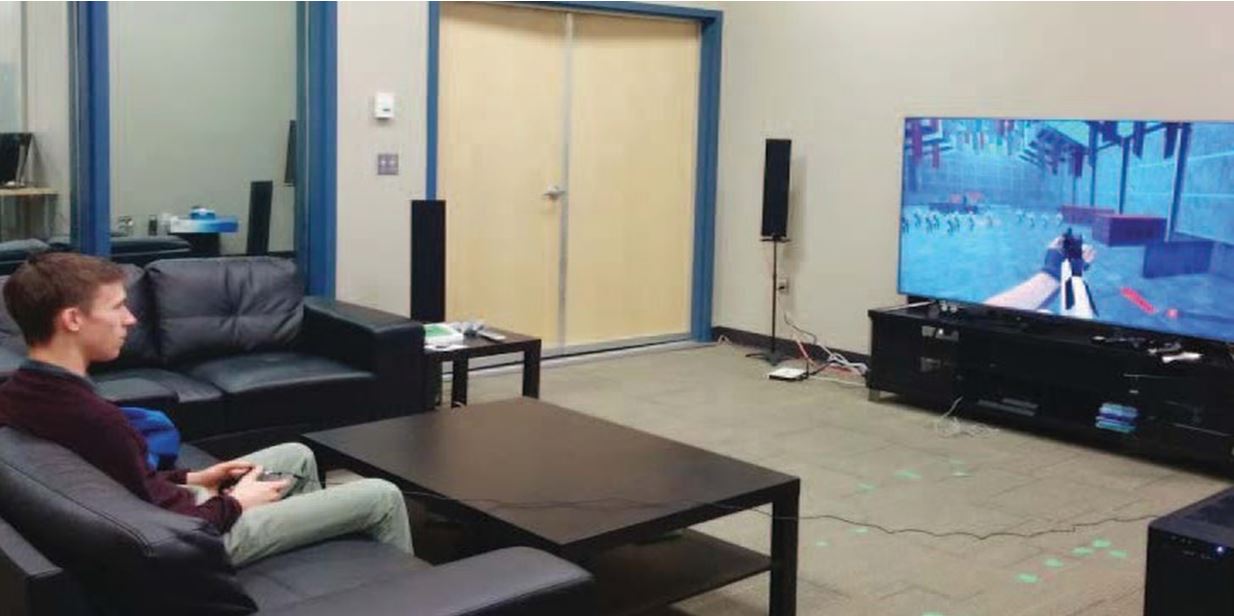 <
<
Fig 3. A participant performing the experiment.
2) Software Setup
A custom game (see Fig. 4) was developed for the study using Unity Technologies' Unity 4.5 engine. The size and position of the ammunition displays were selected based on common sizes and positions in current games. Following publication, the game will be made available to other researchers. The choice to create a game rather than modify an existing one was made for its ability to offer greater experimental control [17] and to facilitate data collection. Using a custom game avoids participant bias towards existing games, a problem noted by Fagerholt and Lorentzon [5].
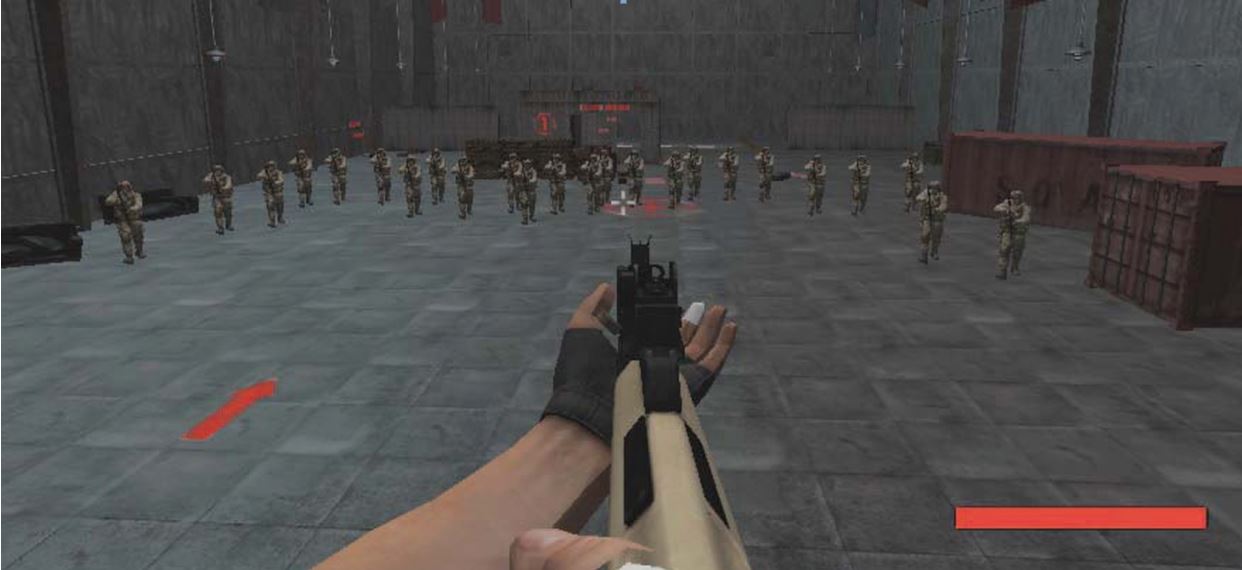
(a)
 (b)
(b) (c)
(c) (d)
(d)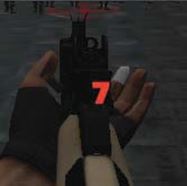 (e)
(e)
Fig. 4. Overall gameplay (with bar on HUD ammunition display) and five conditions: (a) Bar-on-HUD (BH), (b) Number-on-HUD (NH), (c) Icons-on-HUD (IH), (d) Number-in-game (NG), (e) Icons-in-game (IG).
The game was set in a simulated warehouse. There were 25 enemy soldiers initially positioned in a rough semi-circle around the player (Fig. 4, top). The enemies walked slowly towards the participant's character – the player. The player had a rifle, which could execute one shot per trigger press. Enemies died when shot.
The software automatically recorded the number of clips used, hits and misses, enemies remaining, shots before reload, and time before reload. For each shot, the time was recorded along with the remaining ammunition and whether the shot hit or missed an enemy.
C. Procedure
Upon arrival, participants were greeted and the purpose of the experiment was explained. Participants gave informed consent before proceeding.
Participants were instructed to play the game to the best of their ability, shooting all enemy soldiers as quickly and accurately as possible. They were informed that they had unlimited ammunition, but each clip only had a certain number of shots. Consequently, participants had to reload upon running out of ammo. They were then instructed on the controls and were allowed to begin. A trial ended when all enemies were killed.
Upon starting the trial, and after reloading the gun, each clip had a pseudo random number of rounds. The number of rounds per clip ranged from 7 to 16 (decided once per trial). Using a random number of shots per clip was intended to impose greater player attention of the ammunition level. This helped prevent participants from mentally tracking ammunition, and thus was expected to elicit differences between the test conditions. Upon running out of ammunition, participants manually reloaded (and could not reload prior to
running out). This task was representative of real games: Ammunition level becomes crucial when it is low in a battle situation. The task requires participants to be highly aware of their ammunition level.
Participants completed 15 trials for each of the five ammunition displays, completing 75 trials in total. After each trial participants could take a break before continuing. Each trial took between 30 and 45 seconds. In total, the experiment took approximately one hour.
Upon finishing all trials, participants completed a questionnaire about prior experience with FPS games, and soliciting feedback on a 5-point Likert scale on the level of immersion they experienced and the perceived effectiveness of each ammunition display.
D. Design
The study employed a 5 × 15 within-subjects design. The independent variables and levels were as follows:
Ammunition Display: BH, NH, IH, NG, IG Trial: 1, 2, 3, … 15
The ammunition display conditions are depicted in Fig. 4 and were described earlier. The ordering of ammunition display was counterbalanced according to a Latin square.
The dependent variables were the number of shots before reload (count) and time before reload (seconds). Shots before reload is the average number of shots fired from the time when the participant ran out of ammunition to the time when the reload button was pushed. Time before reload is the time between when the participant ran out of ammunition and when the reload button was pushed.
V. RESULTS
Results were analyzed using repeated measures ANOVA.
A. Shots Before Reload
The average number of shots between running out of ammunition and pushing the reload button required that the participant notice that they had no ammunition left. A higher number of shots before reload is indicative of a decreased awareness of ammunition levels. Shots before reload is summarized for each ammunition display in Fig. 6.
Fig. 6. Shots before reload by ammunition display. Error bars show ±1 SD.
The worst performing ammunition displays were the HUD options. All three had comparable scores (slightly over 1 each) and were not significantly different from one another.
Although icons-in-game (IG) performed slightly better, the difference was not significant. The best performing option was number-in-game (NG), which had 0.68 shots fired before reload. Number-in-game resulted in an average 35% fewer shots before reload than the worst performer, icons-on-HUD.
Participants noted that number-in-game (NG) was very easy to see, as the ammunition count was almost directly where they were looking while aiming. The HUD-based displays were in the bottom right corner, requiring more glancing. These ammunition displays performed very similarly, suggesting a relationship between performance and display location. We speculate that positioning the HUD in a different location (e.g., another corner of the screen) is unlikely to yield a substantial performance difference, unless they are placed much closer to the screen centre.
B. Time Before Reload
Like shots before reload, higher scores were worse: the greater this time was, the lower the awareness of the ammunition level. Average time before reload for each ammunition display is depicted in Fig. 7.
Fig. 7. Time before reload for each ammunition display. Error bars show ±1 SD.
Like shots before reload, the icons-on-HUD (IH) ammunition display performed worst, and the number-in-game (NG) ammunition display performed best. NG offered the lowest time before reload, with an average time of 1 s, approximately 20% lower than the next best performing ammunition display, number-on-HUD (NH). The most substantial difference was between icons-on-HUD (IH) and number-in-game (NG) ammunition displays. NG was approximately 26% faster than IH.
The results are surprisingly consistent for both dependent variables. It appears the central location of the number-in-game ammunition display allows for better performance than the other displays. This is most likely because it reduces the amount of gaze shifting or glancing required.
C. Questionnaire
Participants completed a questionnaire soliciting their feedback on the ammunition displays studied. They were asked to rate on a 5-point Likert scale how helpful each ammunition display was. Specifically, they were asked "Did each of the ammunition displays help or hinder your gameplay?" with response options ranging from "Really hindered" to "Really helped". Fig. 9 depicts the percentage of participants for each response level.
Fig. 9. Percentage of participant responses on helpfulness of each ammunition display.
Participants were also asked to rate their immersion on a 5-point Likert scale. Specifically, they were asked "How immersed into the game did you feel with each remaining ammunition display?" Participants felt that number-in-game (NG) was most immersive. Opinions were mixed for icons-in-game (IG), and icons-on-HUD (IH), though opinion leaned towards immersive. Bar-on-HUD (BH) and number-on-HUD (NH) were considered distracting. The differences were significant (χ2 = 15.040, p < .005, df = 4). A post hoc analysis revealed significant differences between bar-on-HUD (BH) and number-in-game (NG), bar-on-HUD (BH) and icons-in-game (IG), and number-on-HUD (NH) and number-in-game (NG). The immersion rating results are seen in Fig. 10.
Fig. 10. Percentage of participant responses on immersiveness for each ammunition display.
Fig. 8. Percentage of responses indicating favourite and least favourite ammunition displays.
VI. DISCUSSION
Overall, results of the study indicate that the number-in-game ammunition display offered the best performance in terms of how long it took participants to recognize they were out of ammo. This is likely due, at least in part, to the placement of the display. Since it was co-located with the player's gun, no additional glancing to HUD elements was required. Participants were able to effectively track their ammunition while otherwise playing the game normally.
Interestingly, this also yielded higher levels of immersion in the game, perhaps because constant glancing at HUD displays reduces immersion. It is likely that participants were intuitively aware of both their performance and their level of immersion. This likely also explains their overall preference toward the number-in-game ammunition display. As noted by previous research [7, 8], players are not inherently opposed to diegetic options if they are effective. The number-in-game ammunition display was clearly the most effective.
That said, the other diegetic display, icons-in-game, tended not to perform as well. It is possible that this is related to a higher cognitive load in counting icons (even if they are located beside the gun) compared to quickly viewing a number. Nevertheless, there seems to be potential for diegetic displays. As mentioned earlier, this bodes well for mobile games with limited screen real estate, as comparatively large HUD elements might be replaced by equally (or more!) effective diegetic options.
This research can assist in the development of future games, as it supports the use of diegetic displays for ammunition with empirical performance results. Developers should always keep in mind that game coherence comes first, as recommended in other research [5]. But, if one of the diegetic displays studied here fits with the theming of the game, and in-game placement improves player performance, then its use is recommended. In some cases, however, it may be difficult for diegetic options, like the ones in this study, to be used because they do not cohere with theming. In these situations, creativity is necessary if a diegetic display is desired. One possibility is to use auditory methods. Investigating auditory communication for remaining ammunition is one area for future work.
Finally, it is worth mentioning two primary limitations of this work. First, only a single display type was studied, so it is unclear how well these results generalize to other display types (e.g., player health). For example, it is unclear if a "number-in-game" type display would offer comparable results for player health as for ammunition display. This is a topic for future study.
Second, we studied ammunition display in isolation from other displays. This is appropriate from an experimental control point of view, and thus enhances the internal validity of the results. However, it decreases the generality of the results. Most games show multiple displays simultaneously (e.g., see Fig. 1), and sometimes combinations of diegetic displays and HUDs, as reported in Table 1. Studying a single display in isolation is not fully representative of this more complex task of monitoring multiple displays at once. However, we expect that even with multiple displays present, those that individually demonstrated better performance are likely to offer better performance together. Hence, we believe studying multiple display types in isolation is worthwhile to "chip away" at the more complex problem of monitoring multiple displays at once. Future work will focus on this goal.
VII. CONCLUSION
Our results show that diegetic ammunition display methods are a good alternative to the traditional HUD display methods. Participants both performed better and preferred the number-in-game diegetic ammunition display method. Since a numerical count of remaining ammunition was in the participants' line of vision, they were aware of the remaining ammunition more readily than other methods, which require more glancing and a higher cognitive load. Ultimately, the number-in-game (NG) ammunition display performed more than 27% better than the alternatives at average shots fired between running out of ammunition and reloading.
This is not to say that diegetic display methods allow gamers to play better, but rather that diegetic displays put information in reasonable locations that allow better performance. In contrast, consider that a HUD element could be positioned in the center of the game space and may yield comparable performance. However, it would be distracting and look out of place, compromising immersion. Instead, diegetic options allow designers to accomplish this in a way that coheres with the game fiction. Per our subjective results, this can be enjoyable, and even preferable to players.
A. Future Work
We intend to conduct experiments investigating display methods for other critical FPS information displays. Our analysis of current games reveal that prime candidates for study include player health, weapon display, and navigational aids. Future work will focus on optimal placement of these information displays, as well as remaining ammunition displays, and comparisons of diegetic vs. non-diegetic options. Eventually, we plan to study multiple display types in a more generalized FPS task. This would likely include combinations of the best-of-class alternatives for ammunition, player health, and navigation based on the results from the current and proposed studies.
REFERENCES
| [1] | E. Kain. (2015, April 3). The Top Ten Best-Selling Video Games Of 2014. Available: http://www.forbes.com/sites/erikkain/2015/01/19/the-top-ten-best-selling-video-games-of-2014/ Accessed August 27, 2015. |
| [2] | D. J. Hill. (Dec. 9). Call of Duty Video Games Reaches $1 Billion In Sales In 16 Days, Faster Than Cameron's Avatar. Available: http://singularityhub.com/2012/01/19/call-of-duty-video-game- reaches-1-billion-in-sales-in-16-days-faster-than-camerons-avatar/. Accessed August 27, 2015. https://doi.org/10.1109/GEM.2015.7377211 |
| [3] | R. J. Pagulayan, K. Keeker, D. Wixon, R. L. Romero, and T. Fuller, "User-centered design in games," in Human-Computer Interaction in Interactive Systems, J. Jacko and A. Sears, Eds., ed: Lawrence Erlbaum Associates, Inc., 2002, pp. 883-906. https://www.academia.edu/download/53046864/User-centered_design_in_games20170508-3449-7jwl56.pdf |
| [4] | N. Schaffer. (2007, April 3). Heuristics for usability in games white paper. Available: https://gamesqa.files.wordpress.com/2008/03/heuristics_noahschafferwhitepaper.pdf Accessed August 27, 2015. |
| [5] | E. Fagerholt and M. Lorentzon, "Beyond the HUD – User interfaces for increased player immersion in FPS games," M.S., Dept. Comp. Sci and Eng., Chalmers Univ. of Tech., Göteborg, Sweden, 2009. https://hdl.handle.net/20.500.12380/111921 |
| [6] | G. Wilson. (Nov. 12). Off with their HUDs!: Rethinking the Heads-up display in console game design. Available: http://www.gamasutra.com/view/feature/130948/off_with_their_huds_rethinking_.php Accessed August 27, 2015. |
| [7] | S. Fragoso, "Interface design strategies and disruptions of gameplay: Notes from a qualitative study with first-person gamers," in Human- Computer Interaction, Part III, HCII 2014, LNCS 8512, Heraklion, Crete, Greece, 2014, pp. 593-603. https://doi.org/10.1007/978-3-319-07227-2_56 |
| [8] | S. C. Llanos and K. Jørgensen, "Do players prefer integrated user interfaces? A qualitative study of game UI design issues," in Proceedings of the 2011 DiGRA International Conference: Think Design Play, Hilversum, Netherlands, 2011. https://doi.org/10.26503/dl.v2011i1.514 |
| [9] | M. Peacocke, R. J. Teather, and J. Carette, "Diegetic vs. non-diegetic game displays," in Poster presented at the IEEE Conference on Games, Entertainment, and Media, Toronto, 2014. https://doi.org/10.1109/GEM.2015.7377211 |
| [10] | D. Conroy, P. Wyeth, and D. Johnson, "Understand Player Threat Responses in FPS Games," in Proceedings of the 9th Australasian Conference on Interactive Entertainment Matters of Life and Death, Melbourne, 2013, pp. 1-3. https://doi.org/10.1145/2513002.2513019 |
| [11] | J. Babu, "Video game HUDs: Information presentation and spatial immersion," Master of Science, Golisano College of Computing and Information Sciences, Rochester Institute of Technology, Rochester, NY, 2012. https://search.proquest.com/openview/a18579eb1df06c3fddfa422656423097/1?pq-origsite=gscholar&cbl=18750 |
| [12] | A. R. Galloway, Gaming: Essays on algorithmic culture vol. 18. Minneapolis: University of Minnesota Press, 2006. https://homepages.hass.rpi.edu/ruiz/EGDFall2013/readings/Galloway%20Origins%20of%20the%20FPS.pdf |
| [13] | M. A. Federoff, "Heuristics and usability guidelines for the creation and evaluation of fun in video games," M.S., Dept. of Telecommunications, Indiana University, 2002. https://ocw.metu.edu.tr/pluginfile.php/2510/mod_resource/content/0/ceit706_2/10/MelissaFederoff_Heuiristics.pdf |
| [14] | V. Zammitto, "Visualization techniques in video games," in Proceedings of Electronic Information, the Visual Arts and Beyond, London, UK, 2008, pp. 267-276. https://doi.org/10.14236/ewic/EVA2008.30 |
| [15] | B. Bowman, N. Elmqvist, and T. Jankun-Kelly, "Toward visualization for games: Theory, design space, and patterns," IEEE Transactions on Visualization and Computer Graphics, vol. 18, pp. 1956-1968, 2012. https://doi.org/10.1109/TVCG.2012.77 |
| [16] | E. Adams, Fundamentals of Game Design: Second Edition. California: New Riders, 2010. https://ocw.metu.edu.tr/mod/resource/view.php?id=2142 |
| [17] | R. J. Teather and I. S. MacKenzie, "Comparing order of control for tilt and touch games," in Proceedings of the 2014 Conference on Interactive Entertainment, 2014, pp. 1-10. https://doi.org/10.1145/2677758.2677766 |



